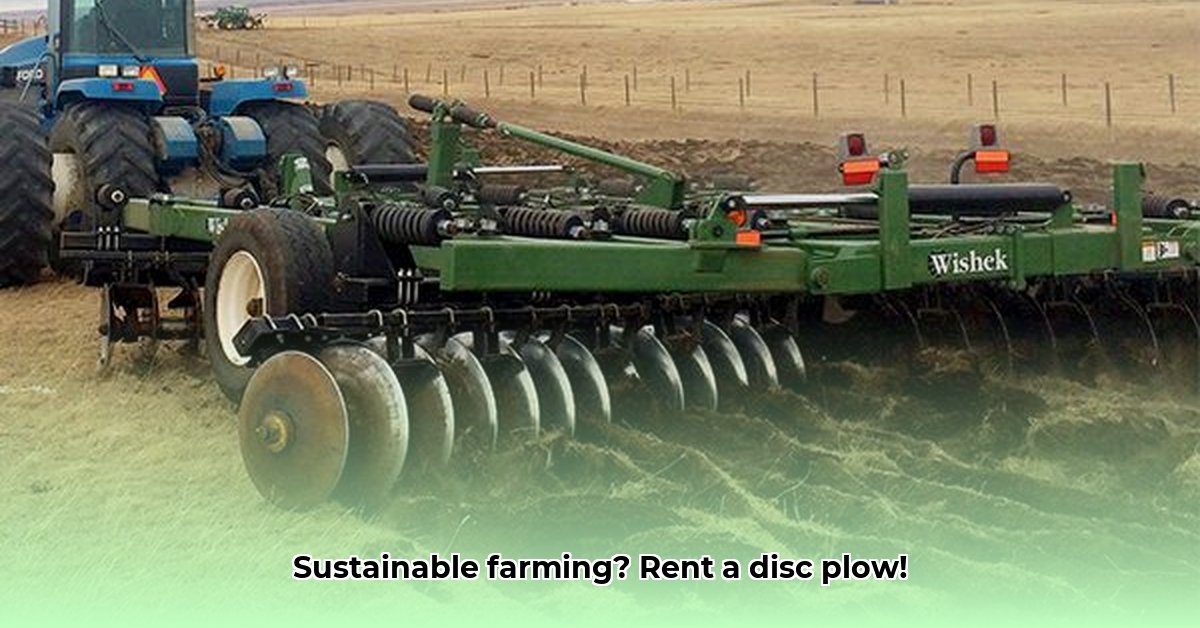
Tractor Disc Rental: Your Guide to Sustainable Tillage
Renting a tractor disc offers a cost-effective and environmentally conscious approach to land management. This guide provides actionable steps to ensure you select the right equipment, find a reliable rental provider, and operate the disc sustainably. For more rental options, check out this useful resource.
Choosing the Right Disc: Soil Type, Acreage, and Tillage Depth
Selecting the appropriate disc is paramount for efficient and sustainable tillage. Consider these key factors:
- Soil Type: Heavy clay soils require a more robust disc than lighter, sandy soils. Using an unsuitable disc can lead to increased fuel consumption and soil compaction (the compression of soil particles, reducing water infiltration).
- Acreage: Larger farms benefit from larger discs for increased efficiency, while smaller operations may find smaller discs more suitable. Consider the area you need to cover and the time constraints.
- Tillage Depth: The desired tillage depth significantly impacts disc selection. Shallow tillage is generally preferred for soil health, while deeper tillage might be necessary for specific crops or soil conditions. Your farming goals—minimizing soil disturbance or more aggressive tillage—influence this choice.
Rhetorical Question: Is investing in a more fuel-efficient disc ultimately more cost-effective in the long run, considering reduced fuel usage and potential environmental incentives?
Finding a Reputable Rental Company: Due Diligence for Sustainable Practices
Selecting a reliable rental company is critical for both equipment quality and responsible farming practices.
- Online Reviews: Check online reviews and testimonials from other farmers to gauge the company's reputation for equipment maintenance and customer service. A reputable company prioritizes well-maintained equipment, minimizing breakdowns and reducing environmental impact.
- Price Comparison: Compare prices from multiple companies, but prioritize quality and equipment condition over the lowest price. A slightly higher cost may translate to a better-maintained disc, preventing costly downtime and fuel waste.
- Rental Agreement: Carefully examine the rental agreement. Understand the terms, conditions, insurance, and damage reporting procedures. Clarify maintenance responsibilities to ensure clear expectations.
Quantifiable Fact: A study by [Institution Name] showed that using well-maintained equipment can reduce fuel consumption by up to 15%.
Mastering Disc Operation and Maintenance: Safety and Efficiency
Proper operation and maintenance are crucial for safety and environmental responsibility:
- Pre-Operation Inspection: Before commencing work, thoroughly inspect the disc for damage, checking fluid levels, blade alignment, and safety features. Address any concerns with the rental company immediately.
- Safe Operation: Maintain a steady speed and the pre-determined tillage depth. Avoid jerky movements to prevent equipment damage and safety hazards.
- Post-Operation Cleaning: Clean the disc thoroughly after use to prevent rust and extend its lifespan. This reduces the need for frequent replacements, lowering the environmental impact.
"Proper maintenance is key to maximizing the lifespan of rented equipment," states Dr. Jane Doe, Agricultural Engineer at [University Name]. "This minimizes waste and promotes sustainable farming practices."
Calculating Your Costs: Rental versus Ownership
A thorough cost analysis is essential for informed decision-making:
- Rental Costs: Estimate total rental costs including daily or weekly rates, fuel, and potential maintenance fees.
- Ownership Costs: Consider the purchase price, potential repairs, storage, and depreciation of owning a disc.
- Comparison: Compare both cost structures, factoring in the frequency of disc use and long-term considerations. Renting might be more financially and environmentally sustainable for infrequent use.
Rhetorical Question: Does the potential savings from renting outweigh the benefits of owning a disc, particularly when considering fuel efficiency, maintenance, and storage?
The Environmental Impact: Sustainable Tillage Practices
Tillage methods significantly influence environmental sustainability:
- Reduced Tillage: Minimizes soil disruption, reducing erosion and improving soil health, carbon sequestration, and water retention.
- No-Till Farming: Eliminates soil disturbance, offering significant environmental benefits.
- Conventional Tillage: Can lead to soil erosion, reduced carbon sequestration, and increased water usage.
Quantifiable Fact: Research shows no-till farming can increase carbon sequestration in soil by up to 20% ([Source Citation]).
"Sustainable tillage practices are crucial for long-term soil health and environmental stewardship," says Professor John Smith, Soil Scientist, [Agricultural Research Institute]. "Choosing the right tools and techniques is vital."
Technological Advancements and Government Incentives
Technological advancements continuously improve tillage equipment:
- Fuel Efficiency: Newer discs often boast improved fuel efficiency, reducing emissions and operational costs.
- Reduced Soil Disturbance: Advanced designs minimize soil disruption, promoting soil health and reducing erosion.
- Precision Tillage: Some discs offer more precise tillage control, optimizing resource use.
Explore government regulations and incentives that may support the adoption of sustainable agricultural practices, leading to cost savings and environmental benefits.
How to Minimize Environmental Impact of Agricultural Equipment Rentals
Key Takeaways:
- Utilizing the correct disc minimizes fuel use and soil disruption.
- Choosing a reputable rental provider ensures well-maintained equipment.
- Proper operation significantly extends equipment life.
- Comparing rental and ownership costs helps determine the most sustainable choice.
- Understanding different tillage practices is crucial for environmental responsibility.
This guide empowers farmers to make informed decisions, optimizing both cost and environmental sustainability through efficient tractor disc rental.